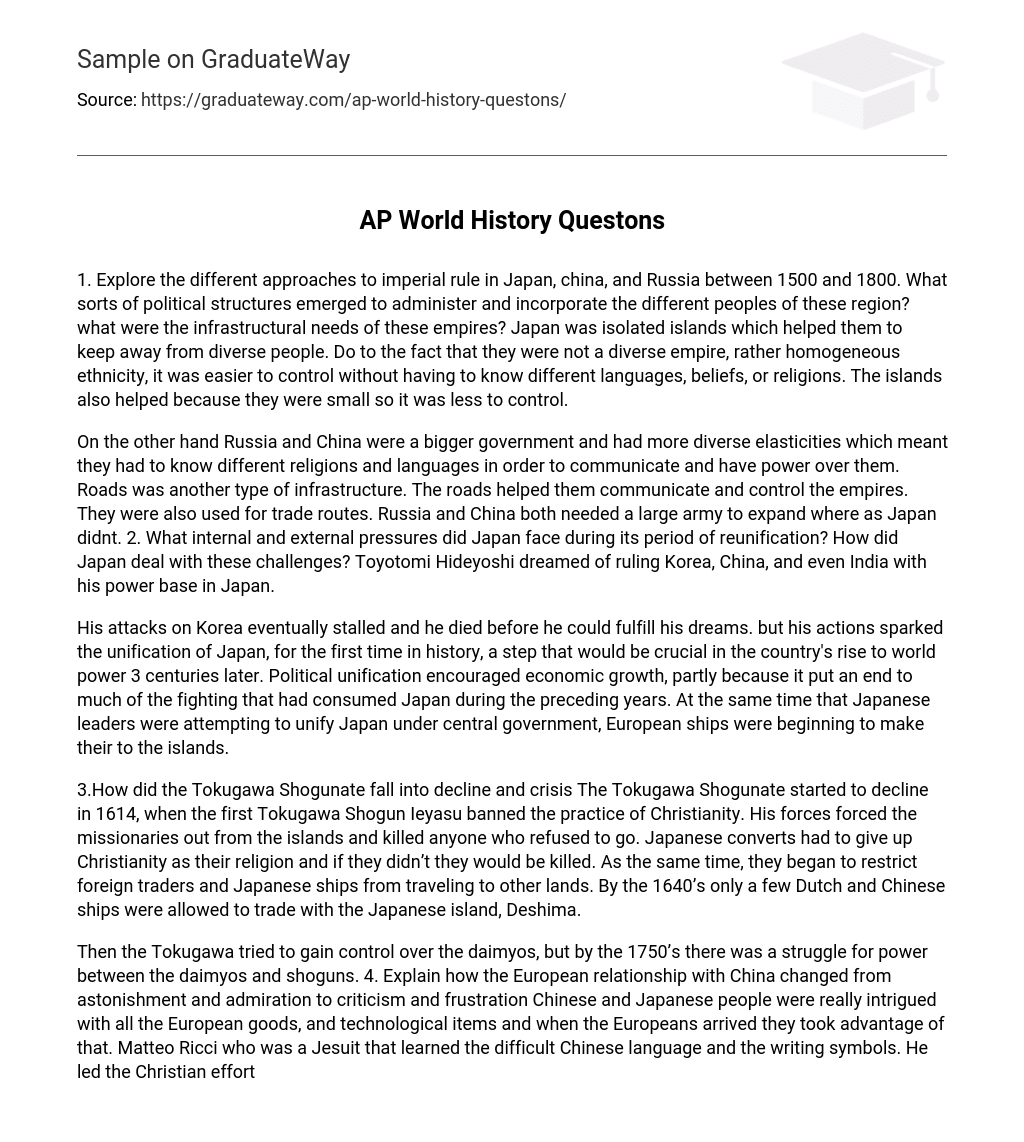1. Explore the different approaches to imperial rule in Japan, china, and Russia between 1500 and 1800. What sorts of political structures emerged to administer and incorporate the different peoples of these region? what were the infrastructural needs of these empires? Japan was isolated islands which helped them to keep away from diverse people. Do to the fact that they were not a diverse empire, rather homogeneous ethnicity, it was easier to control without having to know different languages, beliefs, or religions. The islands also helped because they were small so it was less to control.
On the other hand Russia and China were a bigger government and had more diverse elasticities which meant they had to know different religions and languages in order to communicate and have power over them. Roads was another type of infrastructure. The roads helped them communicate and control the empires. They were also used for trade routes. Russia and China both needed a large army to expand where as Japan didnt. 2. What internal and external pressures did Japan face during its period of reunification? How did Japan deal with these challenges? Toyotomi Hideyoshi dreamed of ruling Korea, China, and even India with his power base in Japan.
His attacks on Korea eventually stalled and he died before he could fulfill his dreams. but his actions sparked the unification of Japan, for the first time in history, a step that would be crucial in the country’s rise to world power 3 centuries later. Political unification encouraged economic growth, partly because it put an end to much of the fighting that had consumed Japan during the preceding years. At the same time that Japanese leaders were attempting to unify Japan under central government, European ships were beginning to make their to the islands.
3.How did the Tokugawa Shogunate fall into decline and crisis The Tokugawa Shogunate started to decline in 1614, when the first Tokugawa Shogun Ieyasu banned the practice of Christianity. His forces forced the missionaries out from the islands and killed anyone who refused to go. Japanese converts had to give up Christianity as their religion and if they didn’t they would be killed. As the same time, they began to restrict foreign traders and Japanese ships from traveling to other lands. By the 1640’s only a few Dutch and Chinese ships were allowed to trade with the Japanese island, Deshima.
Then the Tokugawa tried to gain control over the daimyos, but by the 1750’s there was a struggle for power between the daimyos and shoguns. 4. Explain how the European relationship with China changed from astonishment and admiration to criticism and frustration Chinese and Japanese people were really intrigued with all the European goods, and technological items and when the Europeans arrived they took advantage of that. Matteo Ricci who was a Jesuit that learned the difficult Chinese language and the writing symbols. He led the Christian effort in making Christianity the main religion in China.
When Nubunadu was murdered, his successor Hide Yoshi took over and wasn’t really interested in Christianity. Layasu (1st Tokugawa Shogun) banned the practice of Christianity and killed any missionary who refused to leave. The japans restricted foreign trade in and out of Japan. Question 5: Qianlong canceled tax collections on four occasions and population growth supported trade that headed a large labor force, and commerence was also boosted by the influx of American silver, porcelain, and tea for consumers all over Eurasia. ( the silver & supplies generally helped the Chinese economy.
The Qing government created examinations to become a scholar-bureaucrat only men could take to boost their family social status. Also new food supplies such as; maize, sweet potatoes, and peanuts helped to sustain a rapid increase in population. Question 6: The gradual concentration of political power, supported by actions and policies of its tsars, propelled Russia to the ranks of great empires. There was also military, social, and bureucratic reformations that helped the Russian Empire become one of the major powers of Europe by 1750. . How did Russia combine different cultural elements in its empire? use the cossaks as an example In 1487 Ivan III, also known as Ivan the great, established the “Third Rome”. He acquired new lands through war, marriage, and purchase.
He also recruted peasants, called cossacks, these people settled in the new territories in exchange for their freedom from serfdom. 8. Did Peter really earn the title “The Great” as the first emperor of Russia? How does his reign compare with that of the earlier tsars? nsider the focus of the earlier tsars of Muscovy, while Peter’s focus was on a Russian empire; how did the new emphasis affect Russia and the reception of the tsar? Peter did not earn the title “The Great” because he was the first emperor of Russia. Peter’s reign was different from all of the earliest tsars because he looked to the west as an example of controlling the oceans and seas. He also gained access to the Baltic Sea by builidng a new capital on its shore, St. Peterburg, called his “Window on the West”.





